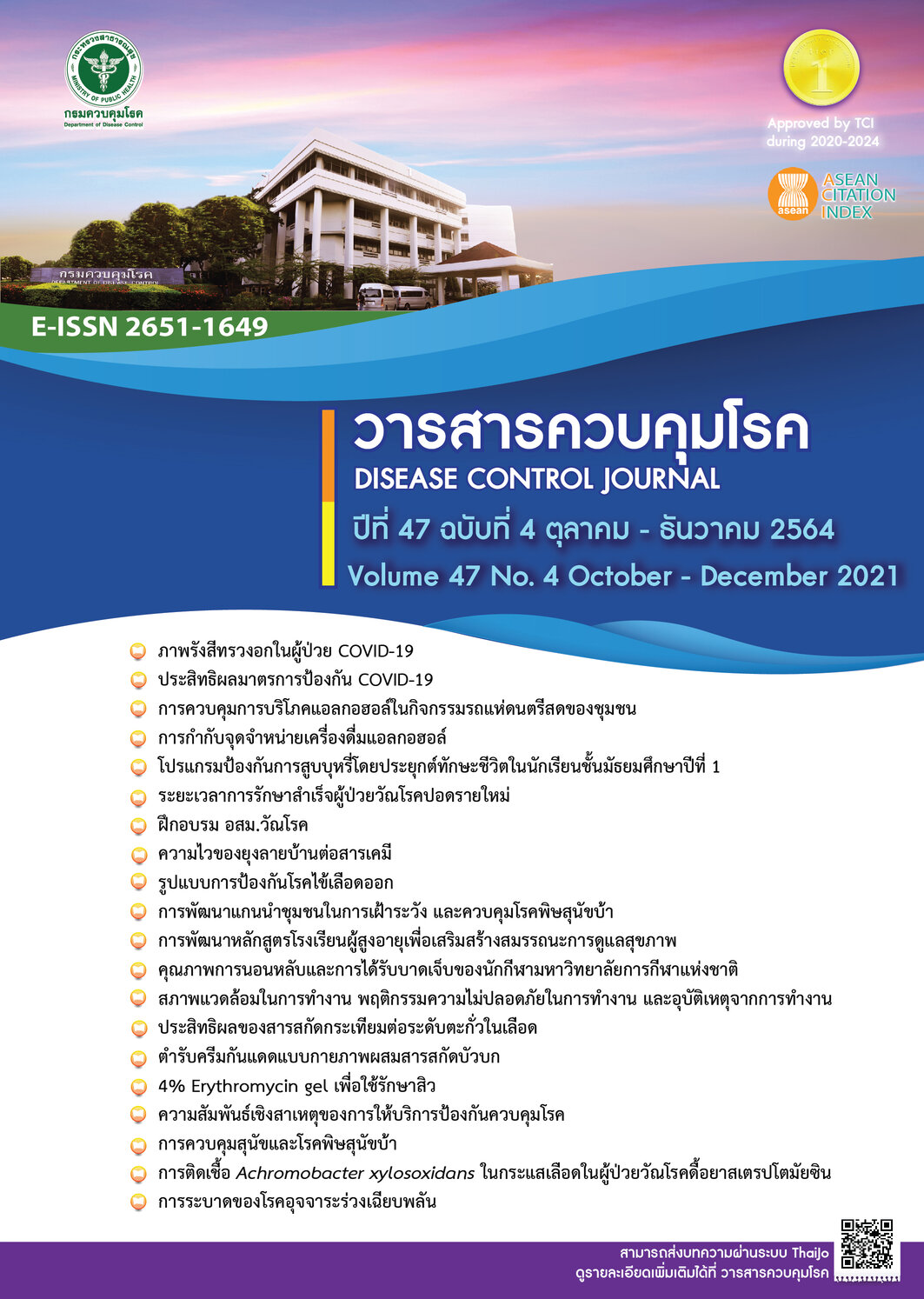Achromobacter xylosoxidans bacteremia in a patient with streptomycin-resistant tuberculosis: A case report
DOI:
https://doi.org/10.14456/dcj.2021.95Keywords:
Achromobacter xylosoxidans, bacteremia, Kaeng Khro, Streptomycin-resistant tuberculosisAbstract
Introduction Achromobacter xylosoxidans can be found in both community and hospital environments. It can cause infection in immunocompromised patients and has many intrinsic characteristics that increase its likelihood of acquiring antibiotic resistance. Consensus guidelines on A. xylosoxidans treatment still remains a challenge; therefore, antibiotic choice must be considered by physician according to individual drug susceptibility patterns. In August 2020, the reported case, 50-year-old Thai male farmer presented to the emergency room of Kaeng Khro Hospital in Chaiyaphum, Thailand, , after experiencing fever with dyspnea for 3 days. He was a smoker (20 pack-years). He had a history of smear-positive pulmonary tuberculosis first diagnosed in 2017 with treatment completed. He had experienced a relapse of pulmonary tuberculosis in November 2018. Mycobacterium tuberculosis grew from sputum culture revealed its resistance to streptomycin. He had been lost to follow-up after 6 weeks of treatment. During this hospital course, he was diagnosed with acute respiratory failure and sepsis, and received endotracheal intubation and intravenous ceftazidime. Blood culture grew A. xylosoxidans with its antibiotic susceptibility pattern showing resistance to gentamicin, cefotaxime, and ceftriaxone, and intermediate resistance to netilmicin. Despite treatment, he died due to respiratory failure. Conclusion There is no evidence showing that pulmonary tuberculosis increase the risk of A. xylosoxidans infection, but bronchiectasis from inadequate tuberculsosis treatment and pulmonary scarring possibly increase the risk of the opportunistic infection in lung and blood stream. Although A. xylosoxidans infection is rare, it is clinically important because of its high mortality rate. In immunocompromised individuals presenting with infection, we should include A. xylosoxidans infection in the differential diagnosis.
Downloads
References
Yabuuchi E, Ohyama A. Achromobacter xylosoxidans n. sp. from Human Ear Discharge. Jpn J Microbiol. 1971;15(5):477-81.
Enriquez M, Favini A, Curl K. Sustained Achro¬mobacter Xylosoxidans Bacteremia in a Patient with Adenocarcinoma of the Colon. Med Forum. 2015;15(1):5-7.
Tugcu D, Turel O, Aydogan G, Akcay A, Salcioglu Z, Akici F, et al. Successful treatment of multiresistant Achromobacter xylosoxidans bacteremia in a child with acute myeloid leukemia. Ann Saudi Med. 2015;35(2):168-9.
Reverdy ME, Freney J, Fleurette J, Coulet M, Surgot M, Marmet D, et al. Nosocomial coloni¬zation and infection by Achromobacter xylosox¬idans. J Clin Microbiol. 1984;19(2):140-3.
Pérez Barragn E, Sandino Péez J, Corbella L, Orellana MA, Fernndez-Ruiz M. Achromobacter xylosoxidans bacteremia: clinical and microbio-logical features in a 10-year case series. Rev Esp Quimioter. 2018;31(3):268-73.
Duggan JM, Goldstein SJ, Chenoweth CE, Kauffman CA, Bradley SF. Achromobacter xy-losoxidans bacteremia: Report of four cases and review of the literature. Clin Infect Dis. 1996; 23(3):569-76.
Weitkamp JH, Tang YW, Haas DW, Midha NK, Crowe JE. Recurrent Achromobacter xylosoxi¬dans bacteremia associated with persistent lymph node infection in a patient with hyper-immuno¬globulin M syndrome. Clin Infect Dis. 2000; 31(5):1183-7.
Gómez-Cerezo J, Suárez I, R-os JJ, Peña P, García de Miguel MJ, de José M, et al. Achro¬mobacter xylosoxidans bacteremia: a 10-year analysis of 54 cases. Eur J Clin Microbiol Infect Dis Off Publ Eur Soc Clin Microbiol. 2003;22 (6):360-3.1102
Benjamin M. Davis, Glen F. Rall MJS. Achro¬mobacter xylosoxidans bacteremia and cellulitis: a report of a case. Pediatr Dermatol. 2015;32(4) :e186-7.
Tena D, González-Praetorius A, Pérez-Balsalo¬bre M, Sancho O, Bisquert J. Urinary tract infection due to Achromobacter xylosoxidans: report of 9 cases. Scand J Infect Dis. 2008;40(2) :84-7.
Reddy AK, Garg P, Shah V, Gopinathan U. Clinical, microbiological profile and treatment outcome of ocular infections caused by Achro¬mobacter xylosoxidans. Cornea. 2009 ;28(10):1100-3.
Ozer K, Kankaya Y, Baris R, Bektas CI, Kocer U. Calcaneal osteomyelitis due to Achromobacter xylosoxidans: a case report. J Infect Chemother Off J Japan Soc Chemother. 2012;18(6):915- 8.
Derber C, Elam K, Forbes BA, Bearman G. Achromobacter species endocarditis: A case report and literature review. Can J Infect Dis Med Microbiol. 2011;22(3):17-20.
Salsgiver EL, Fink AK, Knapp EA, LiPuma JJ, Olivier KN, Marshall BC, et al. Changing epide¬miology of the respiratory bacteriology of patients with cystic fibrosis. Chest. 2016;149(2):390- 400.
Chauhan K, Pandey A, Srivastava S, Gupta A. Pulmonary Infection Caused by Achromobacter xylosoxidans Report of Two Cases. J Clin Diag¬nostic Res. 2019;1-3.
Nakamot S, Sakamoto M, Sugimura K, Honmura Y, Yamamoto Y, Goda N, et al. Environmental distribution and drug susceptibility of Achromo¬bacter xylosoxidans isolated from outdoor and indoor environments. Yonago Acta Med. 2017; 60(1):67-70.
Swenson CE, Sadikot RT. Achromobacter respi¬ratory infections. Ann Am Thorac Soc. 2015;12 (2):252-8.
Hu Y, Zhu Y, Ma Y, Liu F, Lu N, Yang X, et al. Genomic insights into intrinsic and acquired drug resistance mechanisms in Achromobacter xylosoxidans. Antimicrob Agents Chemother. 2015;59(2):1152-61.
Bador J, Amoureux L, Blanc E, Neuwirth C. In¬nate aminoglycoside resistance of Achromobacter xylosoxidans is due to AxyXY-OprZ, an RND-type multidrug efflux pump. Antimicrob Agents Chemother. 2013;57(1):603-5.
Jakobsen TH, Hansen MA, Jensen PØ, Hansen L, Riber L, Cockburn A, et al. Complete Ge¬nome Sequence of the Cystic Fibrosis Pathogen Achromobacter xylosoxidans NH44784-1996 Complies with Important Pathogenic Phenotypes. PLoS One. 2013;8(7):8-11.
Faustini A, Hall AJ, Perucci CA. Risk factors for multidrug resistant tuberculosis in Europe: A systematic review. Thorax. 2006;61(2):158- 63.
Ahmad N, Ahuja SD, Akkerman OW, Alffenaar J-WC, Anderson LF, Baghaei P, et al. Treat¬ment correlates of successful outcomes in pul¬monary multidrug-resistant tuberculosis: an in¬dividual patient data meta-analysis. Lancet. 2018;392(10150):821-34.
Choi H, Jinadatha C, Chatterjee P, Allton Y, Navarathna DH. Draft Genome Sequence of an Unusually Multidrug-Resistant Strain of Achro¬mobacter xylosoxidans from a Blood Isolate . Microbiol Resour Announc. 2020;9(22):9-11.
Downloads
Published
How to Cite
Issue
Section
License
Articles published in the Disease Control Journal are considered as academic work, research or analysis of the personal opinion of the authors, not the opinion of the Thailand Department of Disease Control or editorial team. The authors must be responsible for their articles.






